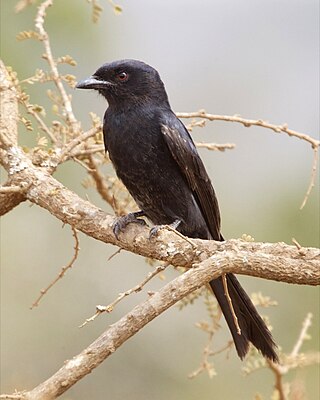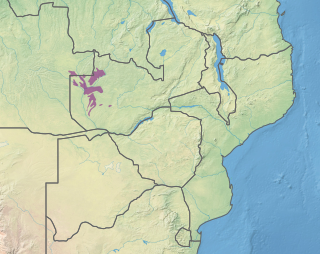
The drongos are a family, Dicruridae, of passerine birds of the Old World tropics. The 31 species in the family are placed in a single genus, Dicrurus.

The fork-tailed drongo, also called the common drongo or African drongo, is a small bird found from the Sahel to South Africa that lives in wooded habitats, particularly woodlands and savannas. They are part of the family Dicruridae and have four recognized subspecies, D. a adsimilis, D. a. apivorus, D. a. fugax and D. a. jubaensis. Like other drongos, the fork-tailed is mostly insectivorous; its diet mainly consists of butterflies, termites, and grasshoppers.

The square-tailed drongo, formerly the common square-tailed drongo, is a passerine bird in the family Dicruridae. It is a common resident breeder in parts of southern Africa.

Richard Bowdler Sharpe was an English zoologist and ornithologist who worked as curator of the bird collection at the British Museum of natural history. In the course of his career he published several monographs on bird groups and produced a multi-volume catalogue of the specimens in the collection of the museum. He described many new species of bird and also has had species named in his honour by other ornithologists including Sharpe's longclaw and Sharpe's starling.

The black drongo is a small Asian passerine bird of the drongo family Dicruridae. It is a common resident breeder in much of tropical southern Asia from southwest Iran through Pakistan, India, Bangladesh and Sri Lanka east to southern China and Indonesia and accidental visitor of Japan. It is an all black bird with a distinctive forked tail and measures 28 cm (11 in) in length. It feeds on insects, and is common in open agricultural areas and light forest throughout its range, perching conspicuously on a bare perch or along power or telephone lines.

The white-bellied drongo is a species of drongo found across the Indian Subcontinent. Like other members of the family Dicruridae, they are insectivorous and mainly black in colour, but with a white belly and vent. Young birds are, however, all black and may be confused with the black drongo, which is smaller and more compact in appearance. The subspecies found in Sri Lanka has white restricted to the vent.

The greater racket-tailed drongo is a medium-sized Asian bird which is distinctive in having elongated outer tail feathers with webbing restricted to the tips. They are placed along with other drongos in the family Dicruridae. They are conspicuous in the forest habitats often perching in the open and by attracting attention with a wide range of loud calls that include perfect imitations of many other birds. One hypothesis suggested is that these vocal imitations may help in the formation of mixed-species foraging flocks, a feature seen in forest bird communities where many insect feeders forage together. These drongos will sometimes steal insect prey caught or disturbed by other foragers in the flock and another idea is that vocal mimicry helps them in diverting the attention of smaller birds to aid their piracy. They are diurnal but are active well before dawn and late at dusk. Owing to their widespread distribution and distinctive regional variation, they have become iconic examples of speciation by isolation and genetic drift.

Jean-Frédéric Émile Oustalet was a French zoologist who contributed greatly to ornithology.

The hair-crested drongo is an Asian bird of the family Dicruridae. This species was formerly considered conspecific with Dicrurus bracteatus, for which the name "spangled drongo" – formerly used for both – is now usually reserved. Some authorities include the Sumatran drongo in D. hottentottus as subspecies.

The spangled drongo is a bird of the family Dicruridae. It is the only drongo to be found in Australia, where it can be recognised by its black, iridescent plumage and its characteristic forked tail. It feeds on insects and small vertebrates. It has complex and varied calls and is a mimic of the sounds it hears. It arrives in Queensland in late spring and breeds high in an isolated tree, producing three to five young each year.

Rück's blue flycatcher is a passerine bird in the Old World flycatcher family Muscicapidae. It is known from only four specimens and is endemic to a small area in northeast Sumatra, Indonesia, inhabiting primary lowland forest. Although all specimens share common characteristics, such as a black bill, brown iris, and black feet, two of the collected specimens show some physical discrepancy with the other two. They were initially described as Cyornis vanheysti before being accepted as specimens of C. ruckii. Rück's blue flycatcher has also been compared to other species of Cyornis.

The southern black flycatcher is a small passerine bird of the genus Melaenornis in the flycatcher family, Muscicapidae, native to open and lightly wooded areas of eastern and southern Africa.

The crow-billed drongo is a species of bird in the family Dicruridae. It is native to moist tropical forests of southeastern Asia where its range extends from India to the Philippines and Indonesia. It is a completely black bird with a shallowly forked tail and is similar in appearance to the black drongo. It breeds between April and June, the cup-shaped nest being built in the fork of a branch by both birds, the female afterwards incubating the eggs. It is a common bird and the IUCN has listed it as "least concern".

The crested drongo is a passerine bird in the family Dicruridae. It is black with a bluish-green sheen, a distinctive crest on the forehead and a forked tail. There are two subspecies; D. f. forficatus is endemic to Madagascar and D. f. potior, which is larger, is found on the Comoro Islands. Its habitat is lowland forests, both dry and humid, and open savannah country. It is a common bird and the IUCN has listed it as "least concern".

The paradise drongo or ribbon-tailed drongo is a species of bird in the family Dicruridae. It is endemic to New Ireland in the Bismarck Archipelago, Papua New Guinea. With a total length of 51 to 63 cm and body mass of 130 g (4.6 oz), this may be the largest species of drongo.

Brazza's martin is a passerine bird in the swallow family, Hirundinidae. It is 12 centimeters (4.7 in) long with grey-brown upperparts, heavily black-streaked white underparts, and a brownish tint to the breast plumage. The sexes are similar, but juvenile birds have more diffuse breast streaking and reddish-brown edges to the feathers of the back and wings. The song consists of a series of short notes of increasing frequency, followed by a complex buzz that is sometimes completed by a number of clicks.

The Zambezian dry evergreen forest, also known as the Zambezian Cryptosepalum dry forest, is a tropical dry broadleaf forest ecoregion of Southern Africa. It consists of several areas of thick forest in western Zambia and adjacent Angola. It is one of the largest areas of tropical evergreen forest outside the equatorial zone.

The Sri Lanka drongo or Ceylon crested drongo, is a species of bird in the family Dicruridae. It is endemic to Sri Lanka. It was previously considered a subspecies of the greater racket-tailed drongo. Its natural habitats are subtropical or tropical moist lowland and montane forests.

















